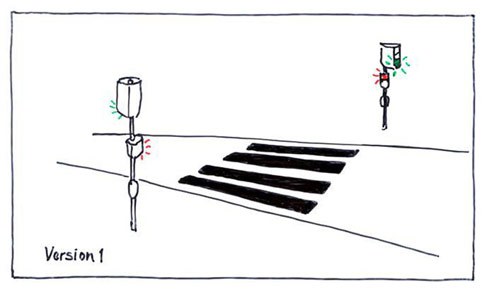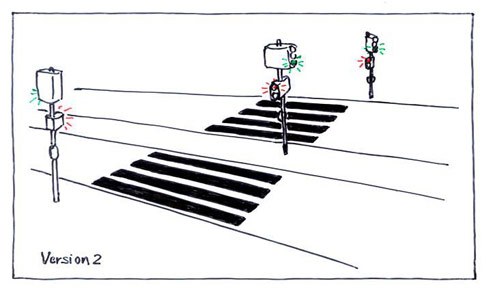Claudia Daems
How do pedestrian lights work?
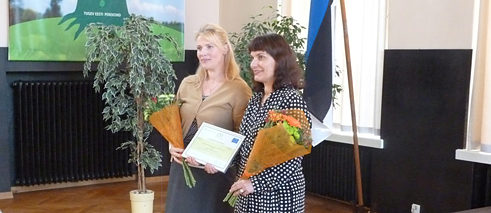
Teaching technology combined with german as a foreign language at university level
ADOK is an acronym that stands for Automatisierung und Deutsch im Online-Kurs (i.e. Automation and German in an Online Course), a freely available Moodle course that was created during the EU’s Lifelong Learning Programme (LLP). Although the course curriculum and online materials are best suited to engineering students, they can also be adapted to other disciplines. This interdisciplinary course teaches students the fundamental principles of automation, gives them a basic knowledge of German for communicating with customers, and provides a reading strategy for understanding technical texts. The course simulates an international project, covering the entire process from ordering to commissioning of a pedestrian light control system.background – the Situation in Finland
The importance of language skills for global business is highlighted in numerous publications. The “Languages for Jobs” report notes that “the demand for foreign languages and communication skills is steadily rising on the European labour market” [1]. As the ELAN study “Effects on the European Economy of Shortages of Foreign Language Skills in Enterprise” showed, a quarter of the 2,000 small and medium-sized enterprises surveyed not only want the English skills of their employees to be improved but also for them to have a command of German, French or Russian and to be able to apply these language skills in all kinds of different work situations [2].The aim is to take a closer look at this situation, using Finland as an example. Employees with German language skills are particularly important for Finnish companies because Germany is the country’s main trading partner alongside Sweden and Russia. However, ever fewer engineers have a command of German at the level B1 or higher according to the Common European Framework of Reference for Languages. There are many reasons for this: pupils at Finnish schools choose German increasingly rarely as their first foreign language, the range of German courses offered at universities is decreasing and such courses that are available are often limited to beginners’ courses.
the Idea for a combined language and content course for engineers
With a view to broadening the language horizons of engineering students at A2 level, automation lecturer Professor Olavi Kopponen and German teacher Claudia Daems came up with the idea of teaching engineering and language proficiency at the same time, using authentic materials already available in the laboratories – in this case manuals from Siemens and software help texts and commands. However, it turned out that Tampere University of Applied Sciences did not have sufficient financial and personnel resources to develop such a course. The EU’s LLP programme provided an opportunity to devise new course curricula. Together with partners they found in three European countries, the two lecturers prepared a project application that was selected for co-funding by the EU in July 2009. The project consortium was made up of four universities and three companies: Tampere University of Applied Sciences (TAMK), Finland (coordination, GFL, automation); the company Toiminimi Ulrike Eichstädt, Finland (GFL); Reutlingen University, Germany (GFL, automation); the company HINTERWAELT, Germany (graphic design); the company InPunkto Software, Germany (programming); Tallinn University of Applied Sciences (TTK), Estonia (GFL, automation) and the Technical University of Ostrava (VŠB), Czech Republic (GFL).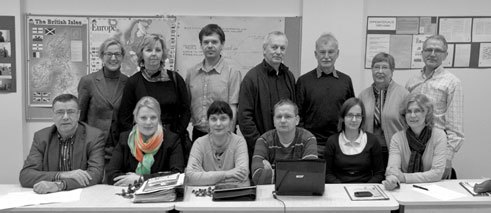 Project group
| Photo: Andreas Berner
Project group
| Photo: Andreas Berner
ADOK – the course you are looking for
Working together, the partners developed a curriculum and materials for an interdisciplinary online course that would combine automation – specifically programmable logic controllers (PLCs) – with German as a foreign language. Designed for the Moodle platform, this online course is available to anyone interested on the Internet. The project website provides a link to the ADOK course and the access data (student rights) so that potential users can familiarize themselves with the course, its structure and its content.ADOK course
description of the course
Interlinking the two subjectsThe two subjects – automation and German – are linked by the learning goals. In both of the subjects, the idea is for students to acquire the ability to tackle problems set in automation projects in German and to solve problems in international project work. Details of the learning goals can be found on the project website.
Definition of learning goals
In practice, the two subjects are interlinked by a project simulation. Students are split into international teams – either real or simulated, depending on the situation at the university in question. Each team plays the roles of both principal and agent. Each team is tasked with ordering pedestrian lights for a busy road. The set task, which is available in two versions together with a solution, includes not only a description of the problem but also a sketch and a list of the functional conditions for the pedestrian lights.
On the basis of this task, each team is provided with a set of technical specifications and the order that it will send to its partner team. The partner team (= the supplier) uses the technical specifications to draw up a graphic representation of the pedestrian light phases and, using the STEP 7 software for the SIMATIC programmable logic controller, writes a program to control the pedestrian lights. The teams communicate throughout the project work, for example to arrange meetings or resolve technical issues. The course ends when the project is handed over, which includes presenting the pedestrian lights. The students learn the programming in their native languages or in English, though authentic back-up material is also available in German. Furthermore, it is also possible to select German for the STEP 7 programming software in the lab. In any case, the students have to communicate with one another in German during the project.
course scope and content
In total, the course encompasses ten study points ( (= 250 hours of student work), with five study points being spent on PLCs, three study points on German, one study point on company visits and one study point on intercultural matters. Ideally, the course runs for two semesters. If required, or if the curriculum permits, the course can be run as an intensive course in one semester (in a semester of 15 weeks this would require 16.6 hours of work on average per week). This is broken down as follows: 25 hours in the classroom for GFL (German for project communication and for STEP 7 texts), 50 hours online (Moodle: teamwork, work documentation, communication between principal and agent); for intercultural matters: 25 hours (classroom-based and online), for virtual and real company visits 25 hours and for PLCs 25 hours in the classroom (programming in general with STEP 7), 50 hours online (Moodle: teamwork, work documentation, communication between principal and agent), 50 hours of lab work (programming on the computer with STEP 7, testing of program on control unit, simulation on pedestrian lights).There are ten modules on the Moodle learning platform:
Module 1: Getting to know team members and PLCs
Module 2: Presentation of task
Module 3: Planning of automation systems
Module 4: Application of PLCs
Module 5: Introduction to programming with STEP 7 + software visualization
Module 6: Project start – programming of pedestrian lights – external communication
Module 7: Company visit
Module 8: Project handover
Module 9: Intercultural matters
Module 10: Reading strategy “Seven Steps to STEP 7”
In parallel to modules 3–8, the students work on programming tasks in the lab. The contents of the online and classroom-based phases are designed to complement each other. The actual rhythm is decided by each university on the basis of its curriculum. The work on and with the PLCs is based on the Siemens SIMATIC guide with the example of traffic light control; this was adapted by the automation teachers and prepared for educational use by the German teachers. Short tests are carried out at the end of each module to check learning progress. In addition, the German-language project documents are assessed. The final test is to present the pedestrian light control system working perfectly.
focus of german lessons
Project communication encompasses introductions, small talk, product presentations, arranging appointments and business communication, among other things. There are exercises for practising written and oral communication. Students can use models that are designed as Moodle tests to practise their written business communication.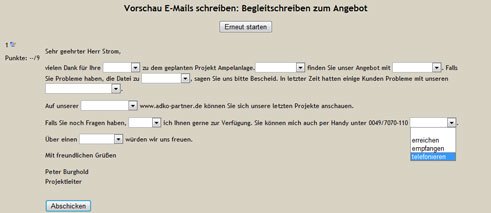 Example exercise, screenshot
| © ADOK project team
The pedestrian light project simulation requires students to have a specific technical vocabulary, which they acquire and consolidate by completing various tasks (e.g. flash cards, cloze tests, matching exercises), tests and texts. The automation teachers compiled a special vocabulary list in German, English, Estonian, Finnish and Czech.
Example exercise, screenshot
| © ADOK project team
The pedestrian light project simulation requires students to have a specific technical vocabulary, which they acquire and consolidate by completing various tasks (e.g. flash cards, cloze tests, matching exercises), tests and texts. The automation teachers compiled a special vocabulary list in German, English, Estonian, Finnish and Czech.
Ways to access authentic texts
To allow students to work with authentic German texts, the German teachers devised the “7 Steps to STEP 7” reading strategy for them on the basis of EuroCom’s Seven Sieves method [4]. The reading strategy teaches the students to access technical texts step by step, proceeding as follows:- Look at the pictures, illustrations, numbers and names.
- Look for international vocabulary.
- Use the special vocabulary list for technical texts.
- Mark the verb in the sentence.
- There are verbs that comprise two parts. Find these verbs.
- Look for structures that are typical of technical texts.
- Find all the remaining unknown words in the dictionary.
In addition, each module uses an example to illustrate a typical structure found in technical texts, with short exercises provided for practice. The main focus here is on identifying and adapting the structures. At this stage, students are not yet required to form the structures themselves. The following structures are presented:
- simple passive,
- verbal nouns,
- verbs with prepositions,
- passive with modal verbs,
- relative clauses,
- participles as adjectives,
- “sich lassen + infinitive”,
- “sein + infinitive”.
Test and Pilot phase
In the autumn of 2010, two modules and steps 1 and 2 of the reading strategy were tested at the four universities participating in the project. When the results of the tests were analysed, it was found that students coped well with the exercises even though the texts sometimes exceeded their language level. The use of the planned reading strategy received a positive response. Students realized that the reading strategy would enable them to access the content of even more complex technical texts. Overall, the exercises corresponded largely to the targeted A2 language level, and the instructions provided were sufficiently understandable [4].Selected tasks and exercises were tested on Belgian engineering students at the Katholieke Hogeschool Kempen (Catholic University Kempen) in February 2011 and in 2012. During the university’s International Week, Professor Olavi Kopponen and Claudia Daems each ran a workshop in which automation and German were successfully combined in a classroom setting. Tampere University of Applied Sciences (TAMK) organized a test run involving a somewhat shorter course (3 study points on PLC and 3 study points on GFL) in the autumn of 2011. Students without any knowledge of German were also admitted to the course, which turned out to be problematic. Although the project process could be simulated, little learning progress was achieved.
The ADOK course was piloted at the four universities from January to June 2012. TAMK and TTK ran the course as a bilateral content-based course. Two international teams were formed. Project communication was organized via Skype and discussion forums in Moodle. An international exchange involving joint lessons in Tallinn (four days) and Tampere (two weeks) was also organized during the pilot course. Working in the laboratories at TAMK, the two teams completed their programming tasks and, together with the German teachers Claudia Daems (TAMK) and Britt Petjärv (TTK), prepared to present their pedestrian light control system in German.
 Students in team 1
| Photo: Andreas Berner
The course was tested in the form of a technical language course at the Technical University of Ostrava (Czech Republic). The focus here was on building vocabulary, identifying typical structures in technical texts and testing the reading strategy.
Students in team 1
| Photo: Andreas Berner
The course was tested in the form of a technical language course at the Technical University of Ostrava (Czech Republic). The focus here was on building vocabulary, identifying typical structures in technical texts and testing the reading strategy.At Reutlingen University, a pilot course was run with exchange students from China and Brazil whose level in German was only A1. So that they could take part in the course, the German teacher Gesine Gruhler adapted much of the material to their specific level and gave instructions in English. For some of the contact hours, she taught together with PLC teacher Professor Karl Armbruster. This allowed highly motivated students to successfully complete the course. [5] A lot more exercise material for the classroom phase was produced during the pilot phase and can be found in the ADOK Moodle course’s “Pool für Lehrer: Aufgaben für Präsenzunterricht” (Pool for Teachers: Exercises for Classroom-based Lessons).
The positive results of the pilot phase encouraged the project partner TTK from Tallinn to take part in the “European Language Label for Innovative Projects in Language Teaching and Learning” competition. This is the European Commission’s way of paying tribute to new approaches to language teaching and innovative projects. The ADOK project won the European Language Label for being one of the most innovative language teaching projects. The certificate was presented on 14 September 2012 during a ceremony at the Estonian Ministry of Education and Research in Tartu.
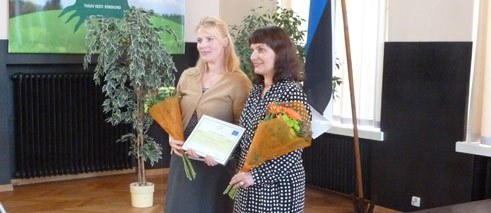 Britt Petjärv, a German teacher at TTK, and Claudia Daems, a German teacher at TAMK, with the European Language Label
| Photo: Roger Daems
Britt Petjärv, a German teacher at TTK, and Claudia Daems, a German teacher at TAMK, with the European Language Label
| Photo: Roger Daems
concluding remarks
The project team hopes that the ADOK course proves to be an inspiring example of interdisciplinary learning and that it will be used in many higher education institutions. To make it easier to work with the course and the wide range of material, a teacher handout has been prepared and can be found below. For each module, the exercises, tasks and materials are described in detail: title, description/type of exercise, method/role assignment, time needed, additional material and recommendations.Teacher handouts
The ADOK course can also serve as the basis for designing a similar course with a different combination of subjects, however. There have been lively discussions of this at many conferences, as well as at other continuing education events.
Literatur
- Report from the thematic working group Languages for Jobs - European Strategic Framework for Education and Training (ET 2020) Languages for Jobs Providing multilingual communication skills for the labour market
- CILT – The National Centre for Languages (Hrsg.) (2006) ELAN: Auswirkungen mangelnder Fremdsprachenkenntnisse in den Unternehmen auf die europäische Wirtschaft.
- ADOK - Automatisierung und Deutsch im Online-Kurs
- Hufeisen, Britta, Marx, Nicole (Hrsg.), EuroComGerm - Die sieben Siebe: Germanische Sprachen lesen lernen, Shaker Verlag, Aachen 2007
- Automatisierung und Deutsch im Online-Kurs, Zwischenbericht, Öffentlicher Teil,
- Automatisierung und Deutsch im Online-Kurs, Abschlussbericht, Öffentlicher Teil,
Author
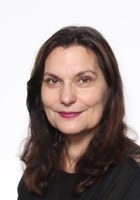 Foto: Studio Kuvattavaksi Oy
Claudia Daems is German but has lived and worked in Finland since 1988. After graduating with a degree in German and history from Leipzig University, she worked as a German and history teacher at schools in Leipzig and Berlin. After moving to Finland, she worked as a German teacher at private schools, numerous Finnish companies, the University of Tampere and the Goethe-Institut Tampere. She was a lecturer in German as a foreign language with a special focus on engineering at Tampere University of Applied Sciences (TAMK) from 1992 to 2013. She coordinated the LLP project ADOK – Automatisierung und Deutsch im Online-Kurs (Automation and German in an Online Course) and the Lingua2 project SPIK: Sprachhandeln in Konfliktsituationen (Language Action in Conflict Situations), and has worked on numerous EU and university projects: DEMA: Deutsch mal anders (A Different Approach to German), PROTOCALL, Just in time, Languages for e-commerce, Virtuelles Wiburg (Virtual Wiburg). Furthermore, she is the author of Deutsch im Display (German on Screen), a text book for German as a foreign language specifically targeted at engineering students and engineers. She is particularly interested in ways of combining language learning with the acquisition of technical knowledge, and in international collaboration when it comes to the creation of teaching and learning material.
Foto: Studio Kuvattavaksi Oy
Claudia Daems is German but has lived and worked in Finland since 1988. After graduating with a degree in German and history from Leipzig University, she worked as a German and history teacher at schools in Leipzig and Berlin. After moving to Finland, she worked as a German teacher at private schools, numerous Finnish companies, the University of Tampere and the Goethe-Institut Tampere. She was a lecturer in German as a foreign language with a special focus on engineering at Tampere University of Applied Sciences (TAMK) from 1992 to 2013. She coordinated the LLP project ADOK – Automatisierung und Deutsch im Online-Kurs (Automation and German in an Online Course) and the Lingua2 project SPIK: Sprachhandeln in Konfliktsituationen (Language Action in Conflict Situations), and has worked on numerous EU and university projects: DEMA: Deutsch mal anders (A Different Approach to German), PROTOCALL, Just in time, Languages for e-commerce, Virtuelles Wiburg (Virtual Wiburg). Furthermore, she is the author of Deutsch im Display (German on Screen), a text book for German as a foreign language specifically targeted at engineering students and engineers. She is particularly interested in ways of combining language learning with the acquisition of technical knowledge, and in international collaboration when it comes to the creation of teaching and learning material.
